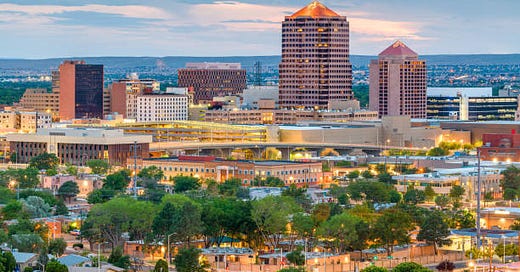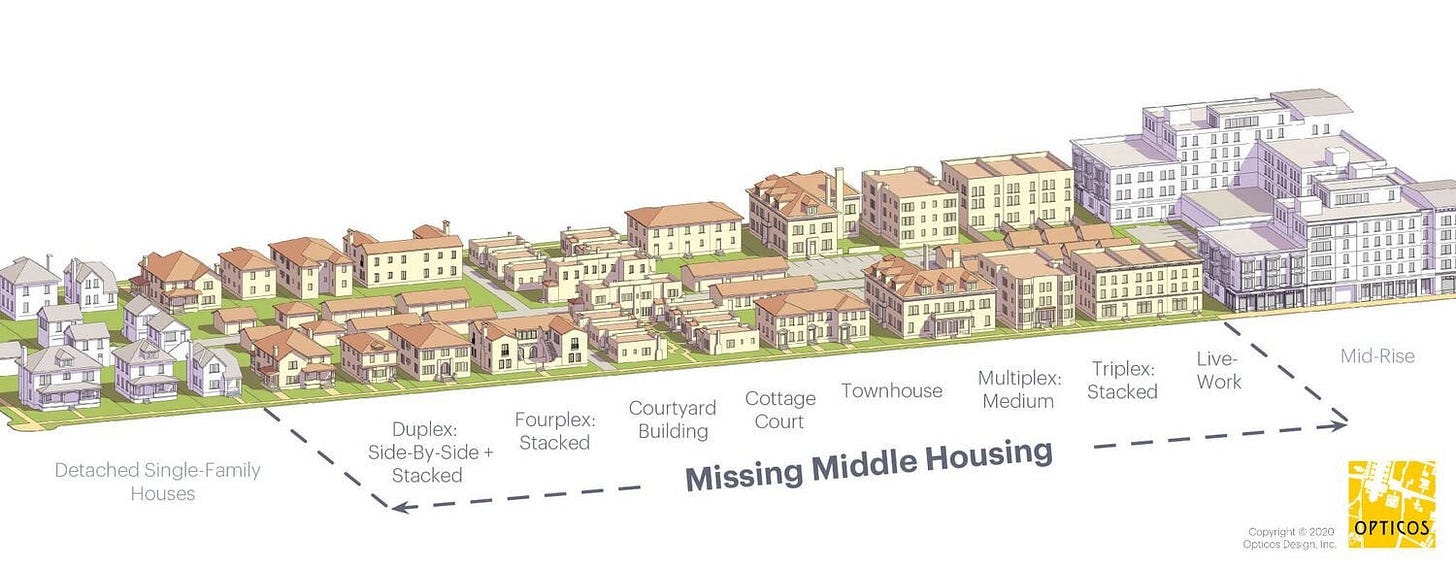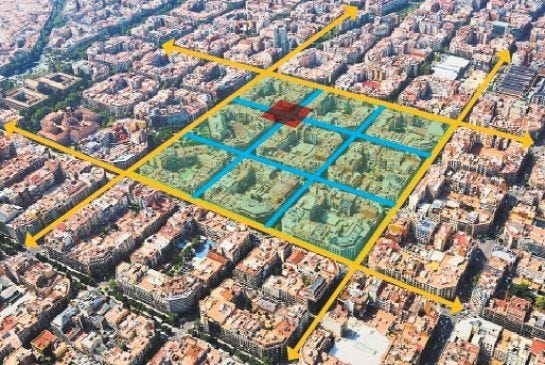Strategic zoning could improve quality of life in Albuquerque
How to build a city with more home-owners, cleaner air, and healthier people
American cities are becoming more expensive to live in relative to average salaries. Albuquerque is no different. Home and rental prices have soared to new heights in 2022, leaving first-time homebuyers without affordable homes to purchase (Albuquerque Journal, Narvaiz, 2022).
Econ-101 classes will explain that prices increase when demand outpaces supply. Most of Albuquerque is zoned for low-density, single-family housing, which restricts the supply of homes and increases the prices.
Albuquerque has become more expensive, and was developed as a sprawling, car-dependent city. While Albuquerque is mostly car-centered, it has implemented some people-first zoning like increased bike lanes, preserving the Bosque, and installing transit like the ART bus and Rail Runner. Albuquerque should now adopt zoning codes that desegregate our communities and decriminalize affordable housing.
Zoning Codes in ABQ
Zoning codes aren’t something we typically think about day-to-day, but we should. They literally shape the world around us. Zoning codes dictate how land is used in various areas which, in turn, affects who has access to certain opportunities. People-first zoning can increase opportunity, walkability, and access to healthy foods while decreasing the cost of living.
In 2015, the CDC ranked New Mexico 2nd in the country in food insecurity, with areas like Albuquerque’s South Valley and International District being of dire concern.
In the South Valley, 57% of people live over a half mile from food access and 75% are Hispanic or Latino. This stands in stark contrast to a NE Heights neighborhood were 5% of people live over half a mile from food and 89% are white.
The difference is the NE Heights neighborhood is zoned to allow for access to essential resources while the South Valley one is not.
As Albuquerque officials grapple with poverty and crime rates in areas like the South Valley and International District, they should explore more diverse zoning. Zoning that would allow the development of affordable housing, address race disparities, and curb climate change.
Zoning comes in many shapes and sizes, but in general, zoning exists in five basic forms as follows:
Residential
Single-family housing, multi-family housing, residential/commercial mixed use
Commercial
Retail business, service business, commercial/residential mixed use
Industrial
Manufacturing
Institutional
Schools, churches
Open Space
Parks, land preserves
Albuquerque is zoned predominantly for single-family housing and commercial uses, but never on the same plot of land. Albuquerque has it’s houses in one area, it’s businesses in another, and plenty of parking around each. The result is comparable to many other US cities: citizens have to own a car and homes are expensive.
The dominance of single-family housing in Albuquerque has roots in the American Dream: everyone must have a house with a picket fence and a car. Although, it’s more than that.
There’s also the banks that flamed the 2008 housing crisis, the hedge funds that are buying up American homes, neighborhoods that fear their demographics will change, and much more. The housing crisis that is unfolding today is dynamic but has solutions that are proven, possible anywhere, and can be implemented slowly.
One great example is the fact that most of Albuquerque isn’t zoned for the varying types of multi-family housing illustrated below:
Multi-family housing can include townhouses, small apartment buildings, big apartment complexes, and everything in between. These homes are typically cheaper, more efficient, conveniently located, and perfect starter-homes.
Most of Albuquerque is zoned for single-family housing, i.e. one family living in a stand-alone house, on a plot of land. This type of housing has become standard but is wildly inefficient, sprawling, car-dependent and too expensive for many homebuyers and renters alike.
If Albuquerque expanded middle housing in strategic parts of the city, they would increase the quality of life for hundreds of thousands of people.
An example of a strategic area would be the UNM/Nob Hill area. Here’s a map showing the mind-blowing domination of single-family housing there:
Yellow = single-family housing
Orange = Multi-family housing
Red = Commercial Retail
Pink = Commercial Services
Brown = Offices
Green = public park
Blue = Institution such as a school, hospital
The limited amount of affordable housing near UNM and Nob Hill is counterintuitive. This area should be able to house many times the amount of people that it does by utilizing multi-family housing and mixed-use buildings. Students are currently being forced to either live far from the school (and own a car), or spend more to live near class and job opportunities.
Furthermore, there is little land available for mixed-use.
Mixed-use zoning is the least abundant type of zoning in Albuquerque. This type of zoning permits commercial and residential uses all under the same roof. Picture a walkable street with businesses and restaurants on the ground level and apartments and condos above.
The City of Albuquerque pumped $133 million into the ART buses that run on Central but hasn’t updated zoning to allow more people to live near it. It’s the same case for the Rail Runner stops. Outside the few available apartments downtown, good luck finding affordable housing within walking distance to public transit in Albuquerque.
Not only would mixed-use zoning laws make Albuquerque more walkable and climate-conscious, it would increase the economic diversity of our businesses by creating space for small, diverse pockets of food and retail development.
More diverse zoning in your neighborhood could mean you have quality grocery stores, farmers markets, schools, churches, offices, transit, etc. all within walking distance from your home.
Here’s a look at the Downtown area, arguably the most walkable area of Albuquerque:
Light yellow = single-family housing
Light Orange = Multi-family housing
Red = Commercial Retail
Pink = Commercial Services
Brown = Offices
Green = public park
Blue = Institution such as a school, hospital
Downtown may have some multi-family housing but it is far from the people-centered urban areas found in Europe and people-centered cities around the world.
Barcelona’s Eixample neighborhoods are a great example of the potential of mixed-use zoning codes. Housing, open areas, car-less streets, food, schools, and more, all strategically exist within a 3 by 3 block, area, (Vox, 2016), as seen below:
Each 3x3 superblock contains zoning for schools, food, offices, green space, and plenty of multi-family housing. The streets also belong to the pedestrians inside the perimeter of the superblock, giving people access to everything within a safe walk from their home.
The idea of the superblock can be implemented in any city, including Albuquerque. The model basically utilizes mixed-use zoning codes and a reprioritization of humans over cars.
Benefits of mixed use development according to the Metropolitan Area Planning Council:
Spurs revitalization
Encourages high quality design
Preserves and enhances traditional village centers
Promotes a village style mix of retail, restaurants, offices, civic uses, and multi-family housing
More housing opportunities
Promotes:
walking and biking
sense of community/place
economic investment
efficient use of land
Improves:
Vitality
Municipality’s Commonwealth Capital score
Revenues
Simple solutions with many benefits
Rethinking our zoning laws is an efficient way to address many of Albuquerque’s fallbacks. We could drastically improve housing affordability, people’s health, the economy, while cutting back on carbon emissions, and much more.
What can we do to improve the zoning laws in Albuquerque, or cities like it?
Share this post on your socials and demand change from your local government officials. The tools for more affordable housing, diversified economic development, and healthier people are available and we need to use them.
How are zoning codes affecting access to certain things in your area? Share in the comments below and subscribe to The Policy & I to gain regular insight on the policies that affect your every day life.










Love this! What a wonderful insight. Thank you for clearly explaining zoning and ABQ’s housing crisis.